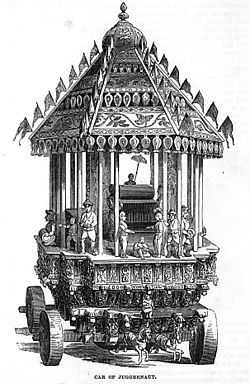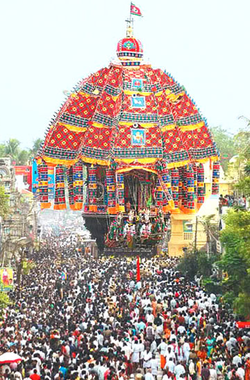This article needs additional citations for verification .(January 2017) |

Temple cars [1] [2] or Temple chariots are used to carry representations of Hindu deities around the streets of the temple on festival days. These chariots are generally manually pulled by the devotees of the deity.
Contents
- History
- Early photographs and lithography of temple chariots
- Largest temple chariot
- Gallery
- List of places with traditional Temple cars
- India
- Malaysia
- Sri Lanka
- Germany
- List of places with golden Temple cars
- Andhra Pradesh 2
- Karnataka 2
- Puducherry
- Tamil Nadu 2
- See also
- References
As of 2004, the Indian state Tamil Nadu had 515 wooden carts, 79 of which needed repairs. [3] Annamalaiyar Temple, Tiruvannamalai, Chidambaram Natarajar Temple are among the temples that possess these huge wooden chariots for regular processions.
The Natarajar Temple celebrates the chariot festival twice a year; once in the summer (Aani Thirumanjanam, which takes place between June and July) and another in winter (Marghazhi Thiruvaadhirai, which takes place between December and January). Lord Krishna of Udupi has five temple cars, namely Brahma ratha (the largest), Madya ratha (medium), kinyo (small), and the silver and gold rathas.
The size of the largest temple cars inspired the Anglo-Indian term Juggernaut (from Jagannath), signifying a tremendous, virtually unstoppable force or phenomenon.




















